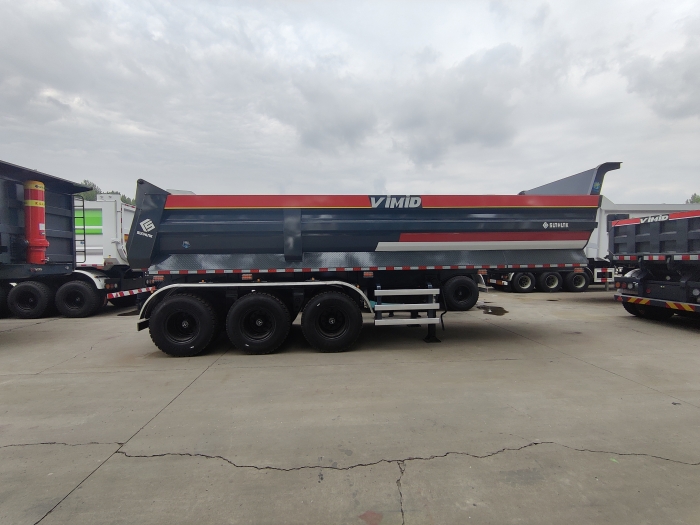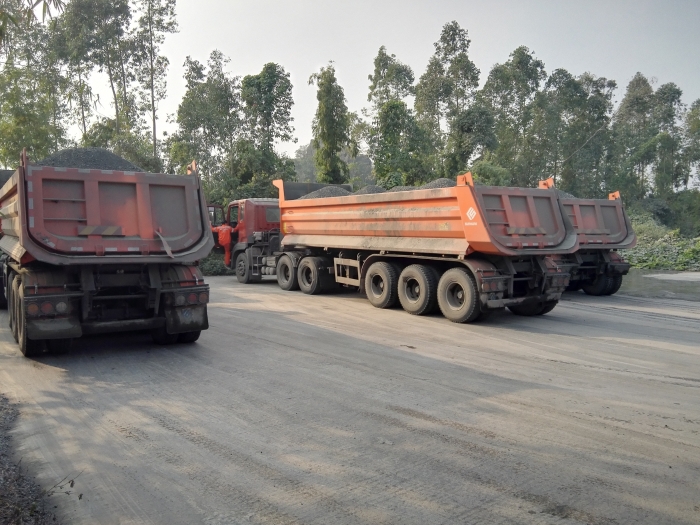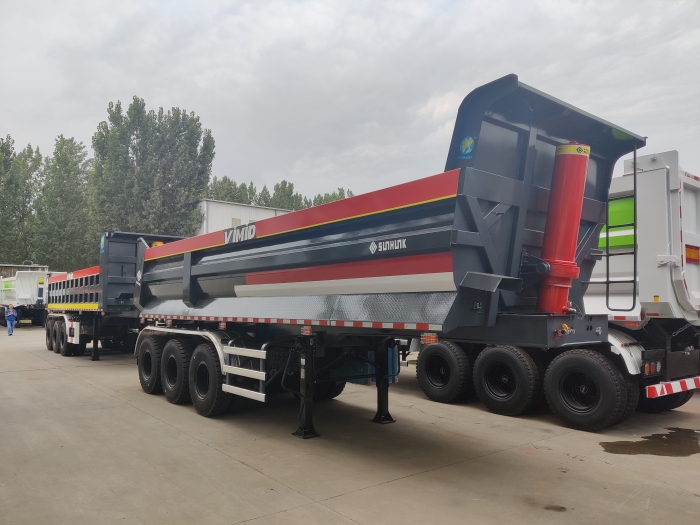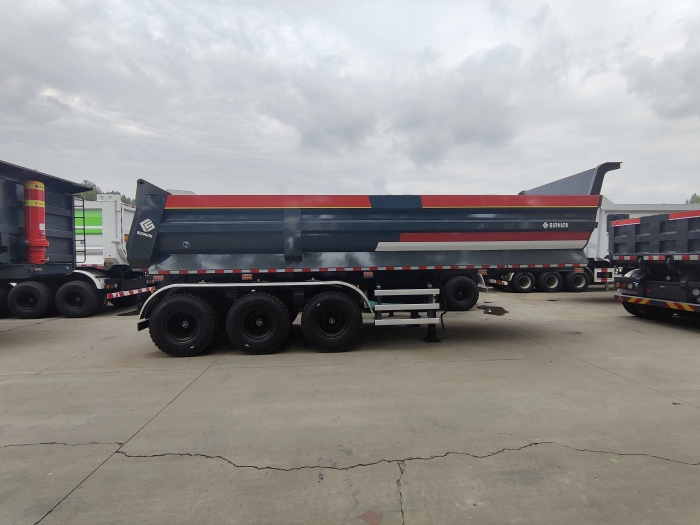- PRODUCTS
- SOLUTION
- SERVICE
- NEWS
- ABOUT US
The maximum weight capacities range from 44,000 to 48,000 pounds for 40-foot and 46,000 to 52,000 pounds for 53-foot semi trailers.

40-foot semi-trailers typically feature a load capacity capacity ranging from 44,000 to 48,000 pounds. This capacity ensures they meet the diverse needs of cargo transport, from lightweight goods to heavier commodities. The ability to carry such a broad range of weights makes these trailers essential for logistics and freight companies aiming to maximize efficiency and profitability.
Materials: The construction materials of a semi-trailer play a pivotal role in its weight capacity. Manufacturers often use high-strength steel or aluminum to strike a balance between durability and weight. High-strength steel offers robustness, whereas aluminum provides a lighter alternative, increasing the net cargo weight the trailer can haul.
Design: The structural design, including the chassis configuration and the distribution of cross members, directly impacts the trailer's ability to support heavy loads. Engineers optimize these designs to distribute weight evenly, enhancing the trailer's load-bearing capacity without compromising its integrity.
Axle Count: The number of axles under a semi-trailer is crucial for weight distribution and legal compliance. More axles allow for a higher weight capacity and help disperse the load's pressure on the road surface, adhering to road use regulations. Typically, a 40-foot trailer is equipped with two or three axles, depending on the intended use and weight capacity.
These factors contribute significantly to the operational capabilities of 40-foot semi-trailers. By understanding and optimizing these elements, manufacturers and operators can ensure their trailers perform efficiently under various load conditions. For more detailed insights, refer to the Semi-trailer Wikipedia page.
53-foot semi-trailers typically boast a weight capacity that can range from 46,000 to 52,000 pounds. This increased capacity compared to the 40-foot models provides logistics companies with the flexibility to transport larger and heavier loads, optimizing their operations and enhancing service offerings to clients who require more substantial transport solutions.

Materials:
o High-strength steel: Offers excellent durability and a higher weight capacity, ideal for heavy-duty loads.
o Aluminum: Reduces the trailer's own weight, allowing for a greater net cargo weight but may not be as durable as steel for certain types of loads.
Design:
o The architecture of a 53-foot trailer, including its longer chassis and additional support structures, is specifically engineered to handle larger loads efficiently. This design not only supports heavier weights but also ensures stability and safety during transport.
Axle Count:
o More axles typically mean a higher weight distribution capability. A standard 53-foot trailer might have three axles, but some configurations include more to support heavier loads while complying with road regulations.
Comparison with 40-Foot Models: The primary differences between 53-foot and 40-foot semi-trailers lie in their design and capacity. The 53-foot models offer a larger cargo space and are designed to carry heavier loads, making them a preferred choice for transporting bulk goods. The additional length and potential for more axles directly contribute to their increased weight capacity, presenting a significant advantage for transporting large volumes of goods in a single trip.
These factors ensure 53-foot semi-trailers remain a versatile and essential component of the logistics and transportation industry, capable of accommodating a wide range of shipping needs while maintaining efficiency and regulatory compliance. For comprehensive details, exploring resources like the Semi-trailer truck Wikipedia page can provide deeper insights into their specifications and uses.
Calculating the maximum net cargo weight a semi-trailer can carry involves understanding two key terms: Gross Vehicle Weight Rating (GVWR) and Tare Weight. The GVWR represents the maximum total weight of the trailer, including the cargo, the trailer itself, fuel, and any additional equipment. In contrast, Tare Weight is the weight of the trailer when it is empty. The formula to determine the maximum cargo weight is straightforward:
To illustrate, let's consider a practical example with hypothetical numbers for clarity:
· GVWR of the semi-trailer: 80,000 pounds (a common maximum for semi-trucks and trailers in the United States)
· Tare Weight of the semi-trailer: 15,000 pounds
Using the formula:
Maximum Cargo Weight = 80,000 pounds - 15,000 pounds = 65,000 pounds
This calculation shows that the semi-trailer can legally carry up to 65,000 pounds of cargo. It's crucial for operators to adhere to these weight limits to ensure safety on the road and comply with legal regulations.
· Accuracy of Tare Weight: Ensuring the tare weight is accurately measured is crucial for legal compliance and safety. Overestimating the tare weight can lead to underutilizing the trailer's capacity, while underestimating it can result in legal penalties and increased wear on the vehicle.
· Regulatory Compliance: Weight regulations can vary by jurisdiction. Operators must be aware of the legal GVWR for the roads they plan to use to avoid penalties.
· Safety Margin: It's often wise to operate slightly below the maximum cargo weight to account for variances in cargo weight estimates and to enhance safety.
Understanding and applying this calculation method allows logistics companies and drivers to optimize their cargo loads effectively, ensuring legal compliance and safety on the roads. This approach to weight management is a fundamental aspect of logistics planning, impacting fuel efficiency, vehicle wear and tear, and the overall cost-effectiveness of transport operations.

Understanding the factors that influence the weight capacity of semi-trailers is crucial for maximizing their efficiency and compliance with safety standards. These factors include axle configuration, material selection, and structural design. Each plays a significant role in determining how much weight a trailer can safely carry.
· Number of Axles: More axles distribute the weight more evenly across the trailer, allowing it to carry heavier loads. For example, a two-axle trailer might be limited to 34,000 pounds per axle group, whereas adding a third axle can increase this limit.
· Spacing Between Axles: Proper spacing is also essential. Closer axle spacing can limit the weight capacity due to increased pressure on a smaller road surface area, whereas wider spacing can enhance capacity.
· Steel: Offers high strength and durability, ideal for heavy loads. However, it adds to the trailer's tare weight, potentially reducing the net cargo weight.
· Aluminum: Lighter than steel, aluminum increases the potential cargo weight but may not offer the same level of durability for extremely heavy or abrasive loads.
· Frame Strength: The design of the trailer frame affects its ability to support heavy loads. Engineers optimize frame structures to balance strength and weight.
· Load Distribution: Effective design also ensures that weight is evenly distributed across the trailer, preventing overloading on any single point.
Impact of Design Optimization: By optimizing these factors, manufacturers can enhance a semi-trailer's weight capacity. This involves a careful balance between durability, weight, and compliance with regulatory standards. Design improvements can lead to trailers that carry more weight safely and efficiently, reducing transportation costs and improving the logistics chain's overall performance.
Table: Summary of Key Factors and Their Impact
Factor | Impact on Weight Capacity | Considerations |
Axle Configuration | Increases with more axles | Must balance with regulatory limits |
Material Selection | Varies by material | Steel for strength, aluminum for lighter weight |
Structural Design | Enhanced with optimization | Must ensure even weight distribution and strength |
Optimizing these aspects ensures that semi-trailers can meet the demands of diverse cargo needs while adhering to safety and regulatory standards. Through continual innovation in materials, design, and axle configurations, the industry strives to improve the efficiency and capacity of freight transportation.
Regular maintenance plays a critical role in ensuring that semi trailers maintain their maximum weight capacity over time. Proper upkeep not only extends the lifespan of the trailer but also ensures it can safely and efficiently carry heavy loads, adhering to legal and operational standards. Below are key maintenance aspects that directly impact a semi trailer's weight capacity.

Axle and Suspension System: Regular checks and maintenance of the axle and suspension system are crucial. These components bear the brunt of the load and are essential for even weight distribution and safe handling. Worn out or damaged parts can significantly reduce a trailer's load-bearing capacity and pose safety risks.
Tire Pressure and Condition: Maintaining optimal tire pressure and condition is essential for safe and efficient load carriage. Incorrect tire pressure can lead to uneven load distribution, increased wear, and potential blowouts, severely impacting the trailer's weight capacity and safety.
Braking System: A fully functional braking system is vital for the safety of heavy load transportation. Regular maintenance ensures the system's reliability, especially under the added strain of heavy loads, contributing to the overall safe weight capacity of the trailer.
Structural Integrity: Inspecting the trailer's frame and body for cracks, rust, or other signs of wear and tear is critical. Structural damage can compromise the trailer's strength and its ability to carry heavy weights safely.
Connection Points and Locking Mechanisms: Ensuring that the trailer's connection points and locking mechanisms are secure and in good working order is essential for safety and load capacity. These points must withstand the forces exerted during transport, preventing any shift or loss of cargo.
Maintenance Area | Frequency | Key Checks |
Axle and Suspension | Every 6 months | Inspect for wear and damage. |
Tires | Monthly | Check pressure and tread depth. |
Braking System | Every 3 months | Test functionality and wear. |
Structural Integrity | Annually | Inspect for cracks or corrosion. |
Connection Points | Before each use | Ensure secure and functional. |
Regular maintenance ensures that each component of the semi trailer functions optimally, directly influencing the trailer's ability to carry heavy loads safely. By addressing maintenance needs promptly, operators can avoid the risks associated with overloading and underperformance, such as decreased fuel efficiency, increased wear and tear, and potential road safety hazards.
In conclusion, diligent maintenance is paramount for preserving the weight capacity and overall performance of semi trailers. Operators who invest in regular checks and repairs benefit from enhanced safety, reliability, and longevity of their fleet, ensuring that their trailers can continue to meet the demands of heavy cargo transport effectively.